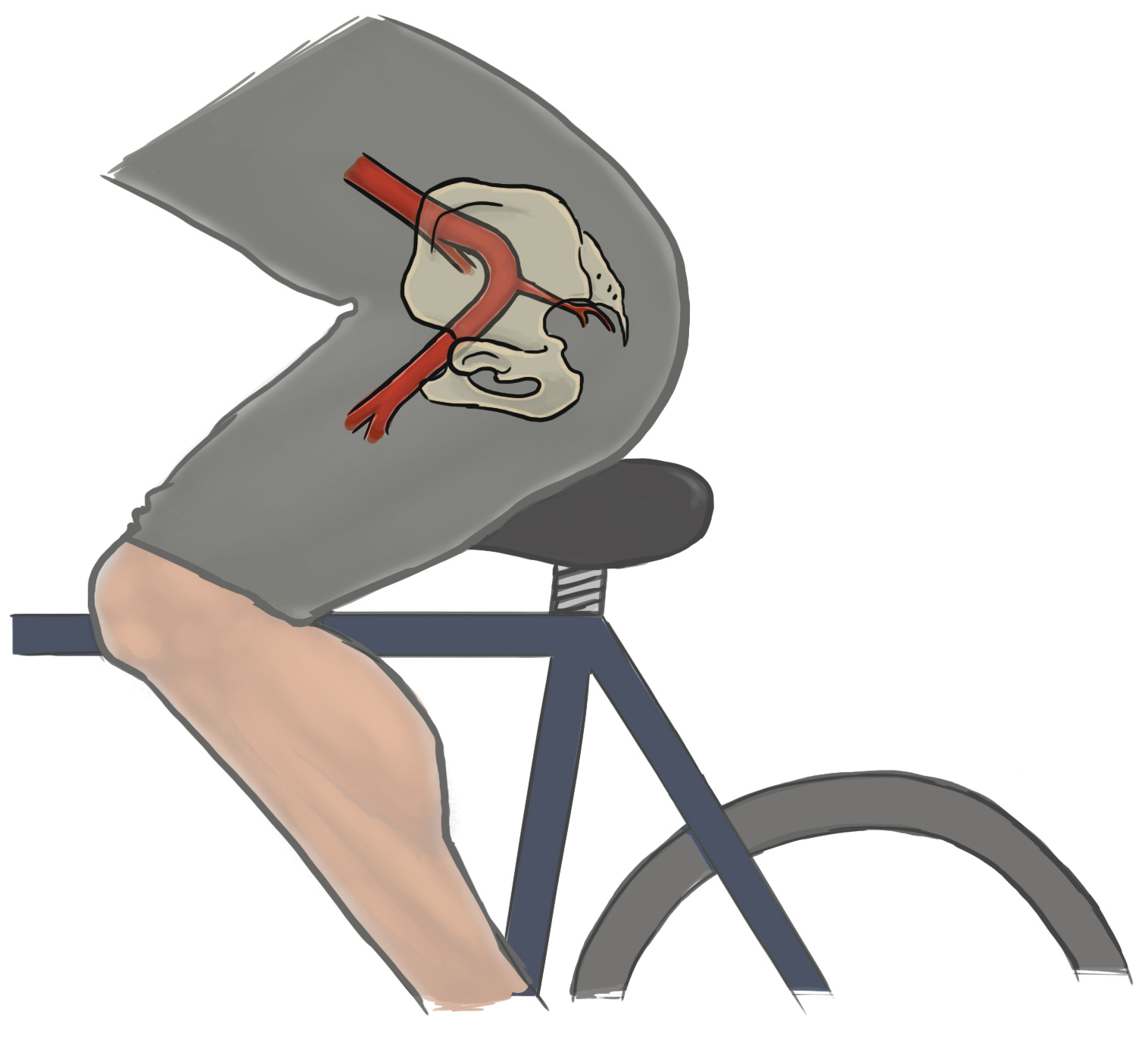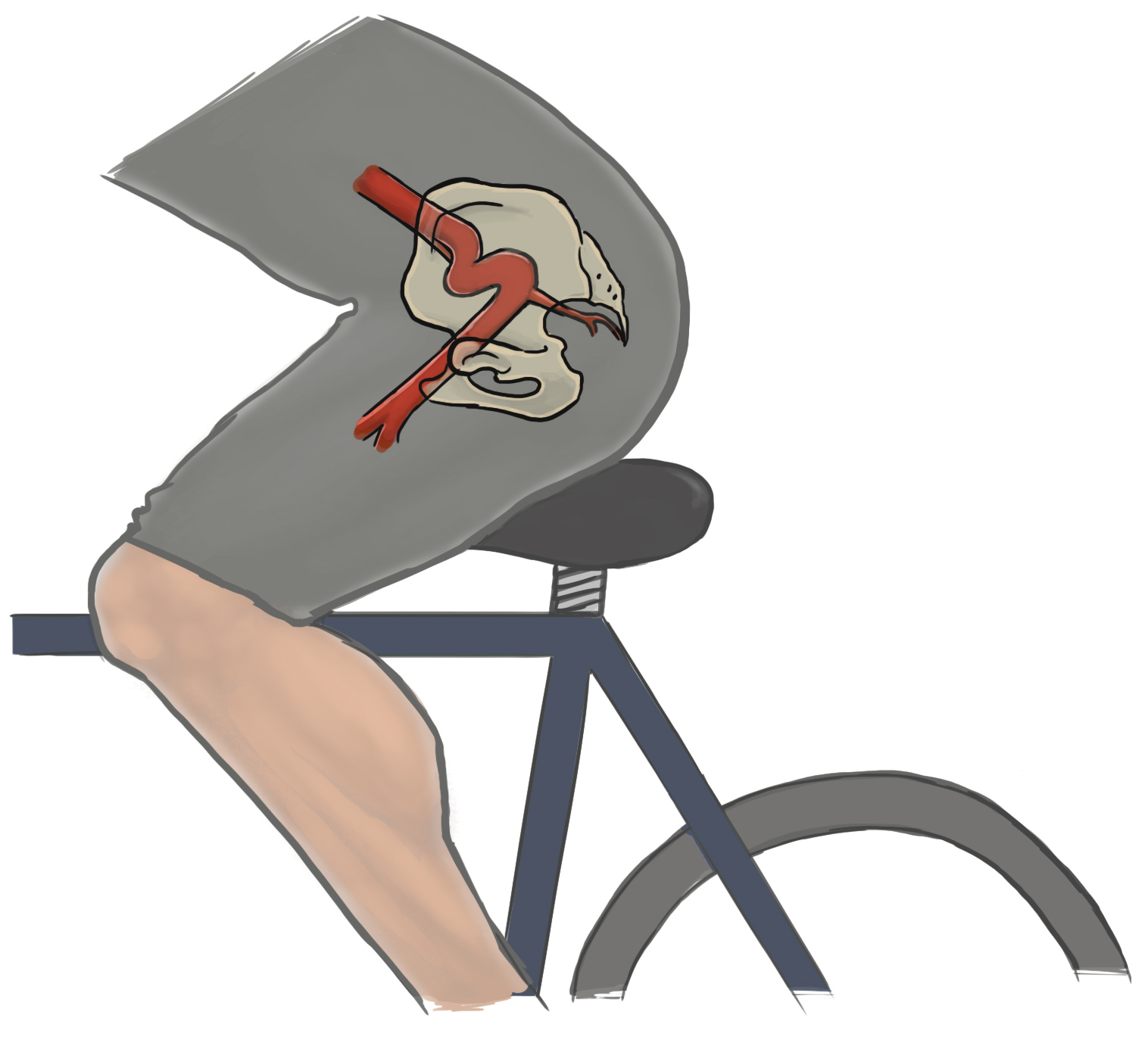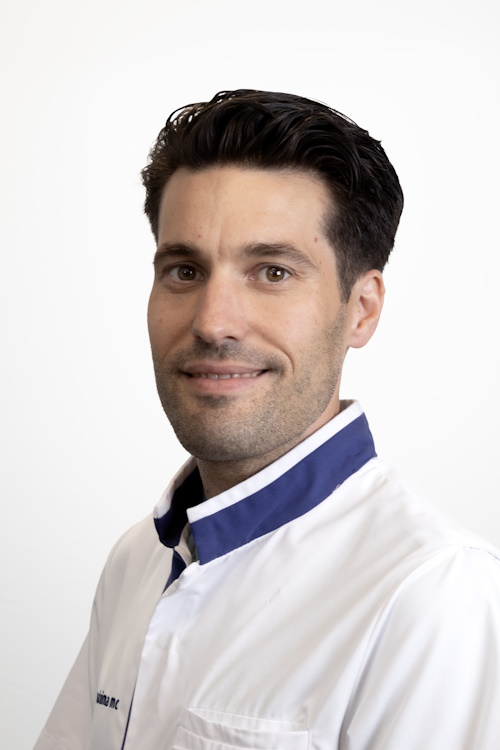Sport-related vascular problem
By:
Dr. Goof Schep †, Sports Physician Máxima Medical Centre
Dr. Martijn van Hooff, Human Movement Scientist Máxima Medical Centre
In short:
- (Functional) narrowing of the iliac artery mainly occurs in cyclists, skaters, and triathletes who engage in very intensive and frequent sports activities with the hip in a bent position. Sometimes it also occurs in long-distance runners or rowers.
- Early recognition often allows for adjustments in sport and/or sports posture (increasing the hip angle) as a good solution.
- Symptoms include pain and/or loss of strength in the leg when exercising above a certain intensity. This is known as the symptom threshold. This threshold can be expressed in cycling speed, heart rate, or power measured with a power meter. Typically, it subsides somewhat quickly when exercising at a lower intensity.
- A self-check has been developed that you can use if you have leg complaints. This helps estimate the risk of flow-limitations in the iliac artery as the cause of your symptoms.
- In cases of severe flow limitations, surgery on the iliac artery is possible.
- About twenty percent of professional cyclists experience symptoms due to a vascular problem in the iliac artery during their career and require treatment/advice. It is unknown how often it occurs in recreational cyclists. However, cyclists who ride for more than five hours per week for over five years are already at risk.
What is a sport-related vascular problem
Your iliac artery supplies blood and therefore oxygen to your leg muscles. Due to the bent position on the bike or in a skating stance, combined with the many revolutions your leg makes, the iliac artery can repeatedly 'kink'. Compare it to a garden hose that gets kinked; the water flows through it less easily, and the flow rate of the water increases. During heavy exertion, this can cause an insufficient blood supply. Over time, this can also lead to damage to the artery.
Deminished blood flow in the artery leads to a lack of oxygen in the leg muscles, causing a feeling of quicker fatigue. This manifests as muscle weakness and pain in your leg muscles. Often, one leg is more affected than the other, and it is characteristic that one leg feels fatigued faster than the other. The symptoms almost always disappear within a few minutes of rest and can often be triggered again within a few minutes when you cycle above the ‘complaint threshold’. You usually do not experience the symptoms very locally in one muscle (as with a muscle injury), but several muscles are involved.
Such symptoms typically indicate a vascular problem. However, they can also be caused by many other factors. Therefore, it is important to determine what is actually happening and what the best approach is. A vascular problem is usually not the first thing a healthcare professional considers with these symptoms in otherwise healthy athletes. That is why a self-check has been developed for both athletes and healthcare providers to help determine if a vascular problem is likely and what the best approach is if it is.
The average athlete with a vascular problem has cycled approximately 45,000 km with their symptoms and consulted multiple healthcare providers before the diagnosis was made. What a shame. The longer it takes to take action, the greater the chance of permanent damage to the artery. Early recognition can lead to adjustments in sport and/or posture or equipment (such as your bike) being a good solution and/or less invasive surgery being sufficient.
 |
 |
Prevention of (further) narrowing and/or kinking of the iliac artery
If you are diagnosed with flow-limitations in the iliac artery
These measures naturally have a significant impact on your sports activities. If there is no vascular problem, they are probably not applicable. Therefore, do the self-check and, if necessary, have your symptoms examined by the recommended healthcare professional to find out what the best approach is for you. |
Operation indication?
- If adjusting the posture is insufficient, and the arterial kinking/narrowing is very severe, surgery might be considered.
- In the early stages of vascular problems, with isolated arterial kinking, the iliac artery is surgically detached from the underlying structures.
- In later stages, a more extensive vascular reconstruction might be necessary. This means that the artery is not only detached but also repaired. If the iliac artery is too long, it is shortened. If scar tissue has formed in the artery resulting in narrowing, the artery is widened by grafting a piece of leg vein. These vascular reconstructions carry more risks.
- Both examination and surgical treatment of these vascular problems are highly specialised procedures and are performed at Máxima Medisch centrum Veldhoven, the Netherlands.
|
| Dr. Martijn van Hooff
Human Movement Scientist |
| Edwin Achterberg
Sports Physician |
| Paul Schreuder
Sports Physician |
| Dr. Goof Schep †
Sports Physician |
| Dr. Maarten Loos
Vascular Surgeon |
||||
 |
 |
 |
 |
 |
More information
|
KTS Sport-related Vascular Problem
The self-check and this article have been developed within the framework of Knowledge Transfer in Sports Health Care* by Sportzorg.nl in collaboration with various experts in the fields of cycling and skating. The group of experts includes athletes, trainers, sports doctors, exercise scientists, a physiotherapist, and a cardiologist. Additionally, important organisations such as KNWU, NTFU, KNSB, NTB, the Doping Authority, and VeiligheidNL are involved with the group.
Athletes, supervisors (both technical and medical), scientists, and other experts collaborate in various expert groups to provide athletes with information based on the latest scientific knowledge. Expert groups have been developed for various topics/sports. The expert group translates scientific research findings into practical applications for sports. The aim is to provide the athlete and their environment with understandable and accessible information. The athlete is central to the KTS methodology.
Click here for publications (scientific articles) on this vascular issue.

 English (United Kingdom)
English (United Kingdom)  Nederlands (nl-NL)
Nederlands (nl-NL)